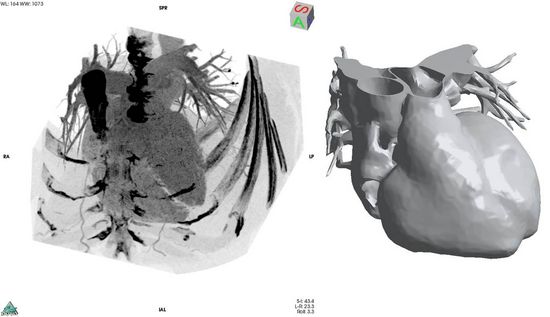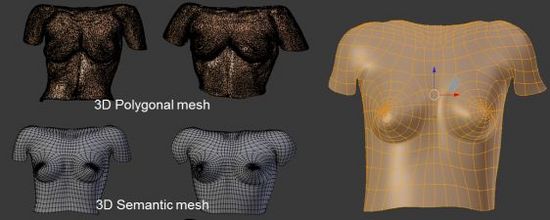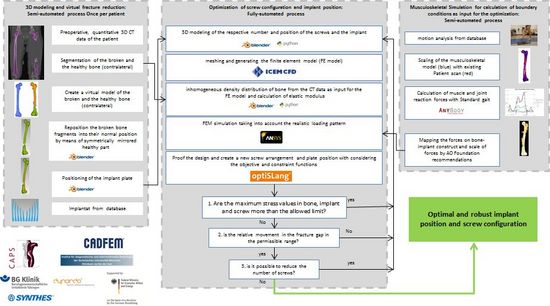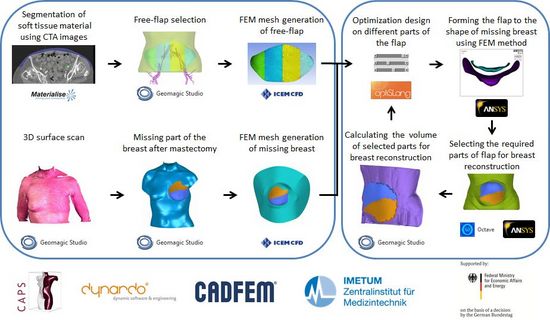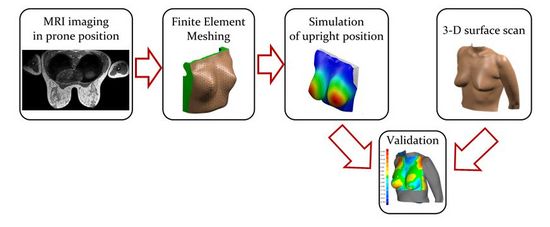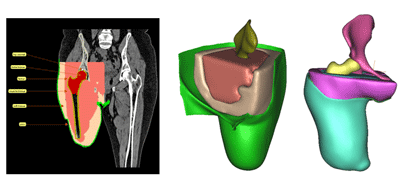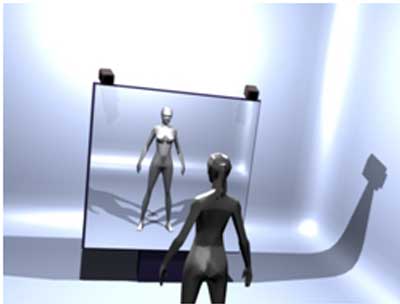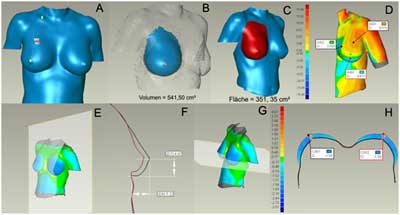Project CAE-Heart - Development of a highly detailed CAE model of the human heart
Sponsorship:
Dieses Projekt wurde kofinanziert durch den Europäischen Fonds für regionale Entwicklung (EFRE).
Aim of the project:
The primary goal of the project is the development of a highly detailed CAE model of the human heart. This model would be generated based on different imaging methods. In the framework of the project, micro-MRI, micro-CT and MR images are taken in order to allow direct comparison of the scanning procedures. The resulting models are to be combined with each other in order to incorporate the advantages of different techniques into the project. In a further approach, histology slices are to be cut, scanned, and stacked in order to generate a 3D model.
Cooperation partners:
• Ludwig-Maximilians-Universität München Anatomische Anstalt - Lehrstuhl I
• Research group Biomedical Physics, Munich School of Bioengineering (MSB), TU- München
• Nuclear Medicine Clinic, University hospital Klinikum rechts der Isar
• Research group Magnetic Resonance Imaging, Munich School of Bioengineering (MSB), TU- München
• microDimensions GmbH
2D to 3D - Development of a method for patient specific 3D model generation based on 2D imaging
Sponsorship:
Federal Ministry of Economics and Technology (BMWi)
Zentrales Innovationsprogramm Mittelstand (ZIM)
Aim of the project:
The project "2D to 3D" is funded by the Federal Ministry of Economics and Technology (BMWi-Funding No.: KF 2061603CR4). The project aims to develop a method for patient specific 3D modelling without the need of expensive hardware components.
Osteosynthese - Development of a method for patient-specific treatment (internal fixation) of bone fractures in the aging society
Sponsorship:
Federal Ministry of Economics and Technology (BMWi)
Zentrales Innovationsprogramm Mittelstand (ZIM)
Aim of the project:
The project Osteosynthesis is funded by the Federal Ministry of Economics and Technology (BMWi-Funding No.: KF 2016102AK2). The project aims to develop a patient-specific optimization of internal fixation using individual biomechanical parameters of bone structure of each patient. This should lead a rapid initial recovery with minimal postsurgical complications for the patient.
Sinus III - Development of a patient specific workflow for planning of breast reconstruction surgery after breast removal due to breast cancer
Sponsorship:
Federal Ministry of Economics and Technology (BMWi)
Zentrales Innovationsprogramm Mittelstand (ZIM)
Aim of the project:
The project SINUS III is funded by the Federal Ministry of Economics and Technology (BMWi-Funding No.: KF 2061601KJ1) and develops a software module for the optimization of surgical breast reconstruction after breast removal caused by breast cancer. To optimize the breast reconstruction using autologous soft tissue from the abdominal region, FEM is used to design the harvested flap shape and geometry preoperatively in three dimensions. The purpose of the study is to optimize the aesthetical and functional outcome and to shorten the operation time by supporting the surgeon with objective 3-D planning details.
Sinus II - Simulation of soft Tissue of the Breast
Computer assisted 3-D body surface acquisition for virtual planning and simulation for surgery in plastic surgery
Sponsorship:
Federal Ministry of Economics and Technology (BMWi)
Executing Organization:
InnoNet, VDI/VDE IT GmbH
Aim of the project:
Development of a patient specific all-in one product for virtual surgical planning in plastic surgery by using the finite element method for the simulation of the deformation of soft tissue. For this purpose the Finite Element Method (FEM) - an established simulation technique - will be adopted for the medical purpose and questions in the field of breast augmentation. The challenge of this project is the development and combination of existing technologies and processes into one product that is optimized for medical use, as well as the evaluation of such a system on a scientifically founded ground. The final all-in-one product should include an 3-D surface scanner and a easy-to use software solution that enables the surgeon to shape the desired result and finally to simulate the necessary surgical steps including the choice of adequate implants.
COPKO - Computer assisted optimization of prosthesis sockets
Sponsorship:
Bayerische Forschungsstiftung (BFS)
Executing Organization:
Bayerische Forschungsstiftung (BFS)
Aim of the project:
The central idea of this interdisciplinary project is the optimization of the mainly empirical production process of amputation sockets. The general idea is to improve this process by using patient specific data for simulation, visualization and production of a socket that optimally fits the amputation stump. For this purpose it is necessary to acquire and then to simulate the major biomechanical interactions between the socket and the soft tissue of the amputation stump during activity. This will be performed with the help of motion analysis in combination with pressure analysis inside the socket during the walking process. With this data the biomechanical relevant changes of the soft tissue are quantified and a physically virtual 3-D model of the amputation stump will be developed. The patient specific 3-D models, the physical and biomechanical parameters will be used by the FEM simulation software in order to simulate the expected interactions between the amputation stump and socket in static as well as dynamic situations. Both - the simulation of the biomechanical interactions and the computer optimized socket - will be the base of a reproducible, individual optimized socket production for exeosceletal prosthesis even with the absence of the patient.
ARO - Augmented reality supported patient education and consultation
Sponsorship:
Forschungsforum des Klinikums rechts der Isar der Technischen Universität München
Executing Organization:
Kommission für Klinische Forschung (KKF) - Klinikum rechts der Isar der TU München
Aim of the project:
The aim of this project is the implementation of an Augmented Reality (AR) based virtual mirror for the enhanced patient information. The development will be based on the example of breast reconstruction performed in plastic surgery. A so called virtual mirror with an interactive Augmented Reality user interface will be developed that enables the doctor to visualize and explain the intended surgical steps in real time. The patient will be able to see his own video image on the digital mirror and a superimposed deformable surface modell from preoperative 3-D surface scan. The surgical outcome can be interactively discussed and optimized step by step with the patient. This project is considered to be a feasibility study for further development and expansion to a wide range of medical discipline.
EraSME SINUS I - Development of a patient specific method for virtual surgical planning in plastic surgery by using 3-D optical scanner systems and haptic technologies.
Sponsorship:
6th EU-Sponsorship and Federal Ministry of Economics and Technology (BMWi)
Executing Organization:
EraSME, VDI/VDE IT GmbH
Destination of the project:
Development of a patient specific method for virtual surgical planning in plastic surgery by using 3-D optical scanner systems and haptic technologies. Target group are the plastic, reconstructive and aesthetic surgeons. More over the new product should provide tools for quantification, comparison and documentation of clinical relevant Information and thus improve the quality management in the workflow. For this goal methods already established in industries are used for medical purpose in order to measure the change of the shape and surface of the human body like e.g. 3-D Scanner and haptic devices. Until now, no products exist that combines all these functions in one device. The challenge of this project is the development and combination of existing technologies and processes into a product that is optimized for medical use, the evaluation of such a system on an scientifically substantiated basis.
